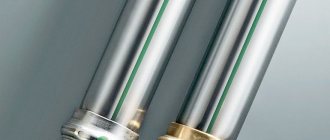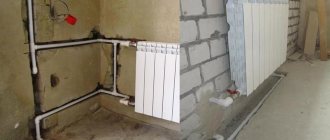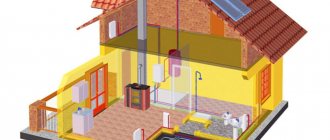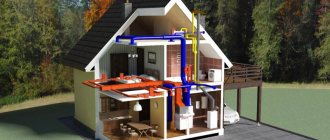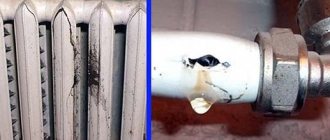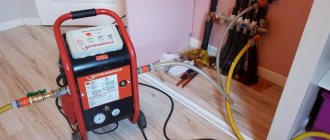There are many apartment buildings with an “in-wall” heating system scattered throughout the former Soviet Union. They can be found both in Moscow and in Murmansk, St. Petersburg, Chelyabinsk, as well as in many cities of Belarus and Ukraine. But what is this “battery in the wall” - a whim or stupidity of Soviet architects? Or an innovation that appeared too early? And what to do with it today: change it or leave it as is?
At what depth are heating pipes in a panel house?
In panel heating systems, the heating devices are steel pipes through which the coolant passes;
pipes are embedded in concrete panels. By combining elements of heating systems with building structures, the prefabrication of construction has increased and labor costs have been reduced. In addition, sanitary, hygienic and aesthetic qualities have increased, and metal consumption has also decreased compared to heating systems in which radiators are heating devices. When installing panel heating, the heating element is placed: in attached window sill panels, partitions, external walls, and also embedded in the ceiling or floor.
Heating panels are a complete factory-made element, and their installation is carried out simultaneously with the construction of the building.
The window sill panel (Fig. 1) is a slab of concrete grade 200-250, into which a coil of pipes with a diameter of 20 mm is embedded. To thermally insulate the panel from the outer wall, an insulating layer of slag wool 30-40 mm thick is laid between the panel wall and the outer wall. You don’t have to use an insulating layer, but in this case you need to leave an air gap of 40-50 mm between the inner surface of the panel and the outer wall.
The panels are installed directly on the floor slab and attached to the external wall.
Window sill heating panels are not widely used due to the complexity of their installation, as well as the need for additional installation of risers and connections.
Partition heating panels are used much more widely (Fig. 2). These panels contain not only heating elements, but also risers, so installation of the system comes down to installing the panels, connecting them with interfloor inserts and laying main pipelines.
The partition panel is a concrete slab 120 mm thick, 800-1000 mm wide and the height of the floor of the room. The panel is part of the partition and is installed near the outer wall.
Partition heating panels can be used in two-pipe and single-pipe heating systems.
The disadvantages of partition panels are: equal heat transfer to two adjacent rooms with different heat losses and the inability to regulate the heat flow into each room, the difficulty of processing the interface between the panels and the partitions (the appearance of cracks), the lack of taps for household adjustment and the large concentrated heat transfer of the panel.
To reduce concentrated heat transfer, heating elements are placed around the perimeter of the partition (Fig. 3).
Currently, the most rational are panel heating systems in which heating elements and risers are embedded in external wall panels (Fig. 4).
In such systems, the number of cold surfaces in the room is reduced, and when the heater is located in the lower part of the outer wall under the windows, the effect of falling cold air flows from the windows is eliminated and the possibility of room-by-room temperature control is provided.
Heating panels are tested at the manufacturer's factory with a hydraulic pressure of 10 kgf/cm2. The panel is considered suitable for installation if no pressure drop is observed within 5 minutes.
The panels are supplied for construction with caps on the ends of the pipes to avoid blockages of the heating elements.
At construction sites, before installing the panel, the heating elements are purged with air to remove scale and debris.
Concept of panel and electric heating
Panel heating system. In this case, pipes are embedded in the structure of the floor, ceiling or wall and hot coolant is passed through them. The heat from the coolant will be transferred to the indoor air by the surface of the building structure itself. Panel heating systems save on metal, provide the best sanitary air conditions, and cause convective currents to be minimal in speed. The mentioned advantages of panel heating and the emerging trend of construction from large-sized elements make panel heating increasingly popular in the construction of trade and public catering buildings.
Electric heating. The principle of operation of electric heating is that an electric current passing through a conductor heats it, and the latter heats the air surrounding it. Reflectors are the most common among electric heating devices. Electric heating does not require fuel storage, its heating devices are lightweight, and the possibility of the devices freezing is eliminated. However, this type of heating is fire hazardous and consumes a significant amount of electricity. Due to these disadvantages, electric heating is not widely used and is used in trade and public catering buildings located in areas with a short heating period as a temporary heating device.
In panel houses, heating pipes are often built into the wall. When moving into a building of this type, people are often surprised by this arrangement of heating elements and even doubt their effectiveness. How productive is such a system? Will there be enough heat in the apartment during the cold season? Let's try to answer these questions.
When moving heating devices indoors or during repair work, the question of pipe routing often arises. Standard schemes: beech P or inverted beech W. Which particular scheme is implemented in your apartment depends on the panel house.
Two risers are located next to each other. Sometimes they are separated by a wall separating the rooms. In this case, the riser has the shape of the letter T, 2 risers are located on one side and one on the other. They pass through the walls. Output of structural connection zones - ceiling and floor.
Heating pipes installed in walls are usually made of metal. The advantages of this material are durability and reliability. In addition, when doing repair work using a hammer drill, you don’t have to worry that the drill will damage the structure. When you come into contact with metal, you can quickly understand that work needs to stop at this point.
Should you rejoice or prepare for the harsh winter period if you moved into a panel house with heating pipes embedded in the wall? Let's consider the pros and cons of this option. Among the main advantages it should be noted:
However, heating pipes in the wall also have disadvantages:
It is difficult to say for sure how effective and convenient heating pipes in the wall will be. It all depends on a person's personal preferences. Some people want to bring the heating pipes inside the room, while others, on the contrary, want to bury them in the wall. But, in any case, it should be remembered that work with risers must be previously discussed with the relevant services. Unauthorized intervention in the design of structures can entail a considerable fine.
Source
Finally, about the scope of application
To avoid problems during operation, use single-pipe heating networks in suitable conditions:
- “Leningradka” works well in one-story dachas and small houses with an area of up to 150 m². If the quadrature does not exceed 70 m², one common ring for all batteries is sufficient, otherwise the system is divided into 2 circuits or a pipeline of a larger cross-section is laid.
- In a 2-story building, you can assemble an open-type gravity single-pipe circuit or a closed version with bottom wiring - your choice. In case of power outages, it is preferable to organize gravity flow and place the circulation pump on the bypass.
- Gravity flow with an accelerating manifold, used in one-story buildings, is characterized by inertia. Radiators warm up slowly, the water cools down greatly due to the low flow rate, and the boiler operates in extreme mode. It is better not to use this circuit at all; it is outdated and will not work normally without a pump.
- Feel free to divide the Leningradka into 2-3 separate floor loops with the optimal number of batteries on each. Do not combine the radiators of all floors into a single circulation circuit - the last devices will remain cold.
- The single-pipe Leningrad system is a suitable option for installing autonomous heating for a 2-3-room apartment.
Experts who prove the indispensability of single-pipe heating systems often refer to Soviet-built multi-story buildings, saying that they have 20 radiators per riser. But they forget to mention the pressure and performance of pumps from a centralized network, which is unattainable in private homes. Do not listen to would-be specialists and use the best system options - two-pipe, collector or associated.
Hiding heating pipes in the wall - pros and cons
Very often, during construction work, heating pipes are hidden in the wall; the pros and cons of this method of hiding pipes need to be studied thoroughly to determine whether this method is suitable for you or not.
Otherwise, not only the functioning of the heating, but also the design of the room may suffer. It is better to carry out hidden pipe laying at the construction stage. In an already functioning house, this issue is much more difficult to resolve. If previously communications were left attached to the walls, then a significant advantage of modern high-quality repairs is that these options are not acceptable.
What should you prepare for?
If we talk about private cottages, then such a heating distribution can be used there, but the owners need to prepare for some difficulties. An example of such a problem is that most batteries on the modern market are designed for connection to horizontal systems; they have the appropriate arrangement of pipes, technological holes and sections. Thus, the circuit, ideally, needs special radiators designed specifically for vertical installation.
Another problem arises from this feature. As you know, it is better to install radiators closer to the floor, this will allow for effective air exchange without unnecessary effort. Cold air, according to the laws of physics, will fall down, and heated air will rise up. A vertical radiator is extremely difficult to install in this way, which is why the heating is insufficient.
Is it possible to hide heating in the walls?
Many people are interested in whether it is possible to hide heating pipes in the wall. There are quite a lot of supporters and people with opposing opinions of the described method. Some argue that this cannot be done, others say that it is possible to hide the heating in the wall.
So, is it still possible or not? Which opinion is correct, and what are the pros and cons of such decisions? And, in order not to keep the intrigue for long, you need to answer that you can use this method. And they use it very often.
This is an effective option for hiding unsightly pipes in your home. There is no technical need for such actions, and in terms of operation it is quite possible to do without it.
Consensus on this issue, as well as on the only correct version of the gasket, has not yet been found. Therefore, everyone will make their own decisions, after carefully weighing all the pros and cons.
Initial work
Layout of heating batteries on the balcony.
- Bulgarian.
- Hammer.
- Steel plates.
- File.
- Cement solution (1 share of cement, 3 shares of sand, as much water as required).
- Polyurethane foam.
The next step is to install the mounting system into the load-bearing wall. The easiest way to do this is to use a steel plate, which has a thickness of up to 2 mm and a width of 25-30 mm. The length of such a plate will be arbitrary, but preferably 300-350 mm, in order to place it at a sufficient distance beyond the load-bearing wall, but at the same time fully maintain the strength of its fixation. To do this, use a hammer drill to hollow out a series of holes to a depth of 50 mm, then they are cleaned and you can try to install a steel plate there. If the plate fits in freely enough, then you can fill the hole with cement solution, where the plate is immediately reinserted. Some prefer to use mastic or other available material instead of cement, which is quite possible, but be sure to take into account the thermal effect when choosing.
Next, in the place where the radiator will be directly installed, you should use a grinder to make small recesses so that the entire structure can be mounted there without being afraid of any surprises. The ideal option is to finalize everything with a file, so as not to leave any pointed ends and to round off existing corners.
Loggia heating scheme.
After this, 2 places on the main pipe are selected where additional batteries will be connected, one of which will supply water, and through the other it will be discharged. Opposite these places, you should use a hammer drill to organize through the walls. Load-bearing walls have one characteristic feature - they are often so wide that it is extremely difficult to select a drill, and often you even have to make 2 holes opposite and carefully try to match the joint. After the holes are made, they can begin to be expanded to the diameter of the pipe plus 0.5 cm, because it will be physically impossible to insert the pipe into a hole made end-to-end. After complete installation, it will be possible to fill the hole with foam or other filler that will be sufficiently sealed and resistant to temperatures. You can't leave weak spots near the walls, because... Although they will not play a role in the quality of heating, they will allow drafts to pass through.
Hidden broach
Laying heating pipes in the wall is a fairly popular practice.
This is justified by the fact that heating communications greatly spoil the interior space. This is their big disadvantage. They stretch along the walls, catch the eye, and do not add any attractiveness to the overall design. For these reasons, many people want to hide them. Heating can be installed in different ways, but the most common of them is installation in the wall. At first glance, this is a very good solution, the pipe is completely hidden, the overall appearance of the room has improved a lot, but is everything really that simple, and what are the advantages of this solution?
Often, when laying a heating network in the walls, the joints lose their sealing. As a result, leaks form. It is impossible to see such places on a hidden pipeline, and defects can only be identified using a water pressure sensor.
All modern heating devices are equipped with such a device. When determining a leak, you need to determine the location of the accident and make repairs.
If, after weighing all the pros and cons, and it is decided to lay a heating line in the wall, then the surface covering must be designed in such a way that access to possible emergency zones is free.
For these reasons, the cladding is made of plastic panels, lining, plasterboard, etc. The disadvantages of various decorative plastering is that in the event of an accident the wall will have to be dismantled, and this is not only physical, but also financial costs.
Advice! When laying a polypropylene system using a hidden method, it is first necessary to conduct strength testing. In this case, the test load must exceed the normal operating mode by no less than 1.5 times. It is not recommended to use this method of laying for metal systems, due to their significant disadvantage - poor resistance to corrosive formations.
One more nuance should also be taken into account. The downside of the plastic system is the linear increase during heating. During installation, this minus must be taken into account.
Radiator installation
It is difficult to carry out all installation work independently without experience. To save money and time, it is better to invite a professional plumber to do the work. If this option is excluded, and the work will be carried out independently, you need to prepare work equipment:
- sealant;
- Mayevsky crane;
- welding machine;
- control and shut-off valves;
- roulette;
- foot nuts and plugs;
- die and vice;
- pipes;
- perforator;
- Bulgarian;
- fitting.
Connection is carried out using the following technology:
- Connection to the main pipe. Using a grinder, make small cuts on the outside of the threads on the pipes and fasten them with fittings that have additional branches. To ensure waterproofing, use fum tape or tow.
- Pipes with threads applied to them are passed through holes in the wall. They should protrude beyond the wall by approximately 8-9 cm. A corner fitting is attached to the second end of the pipe, which should occupy a strictly vertical position in space.
- They hang the radiator. You need to use a pencil to mark on the wall the places where the brackets will be attached. Using a hammer drill, a hole is made in the wall and the bracket is secured.
- The battery is secured by placing a rubber washer between the parts and the bracket.
- Using a building level, adjust the location of the radiator.
- The liner is being connected. Two pipes about 25-30 cm long come out of the radiator, one end is connected to the battery, and the other is closed with a fitting.
- Finally, proceed to the vertical installation of pipes, which are necessary for supplying and removing coolant from the radiator. They are screwed into ready-made fittings; all connections must be sealed.
How to hide a heating system in an apartment - let's look at the methods
Heating pipes can be hidden in panel walls in several ways. And for this room there are not so many of them. The first option in panel houses is the use of grooves, and the second way is the construction of false walls. Each of the options has pros and cons, and you need to make a decision for yourself after studying these methods in detail.
A heating pipe can be hidden in the wall of a panel house when a new circuit is being assembled, or repair work is being carried out in an already functioning structure. As a rule, the wall of a panel house and the heating main are placed in different planes.
And when it is necessary to bring them into one plane, recesses are cut in the panel walls and the heating line is placed there. When doing this, you need to pay attention to the following points:
To facilitate the work of chiselling a wall in a panel house, it is recommended to use a grinder. First, markings should be made, and then along the corresponding lines, indentations are made to a certain level of depth.
ADVICE! When working with an angle grinder, not only a lot of noise arises, but also dust. Modern tools have a big advantage - the function of connecting to a construction vacuum cleaner, and this prevents the appearance of dust.
According to existing rules, the communication network in the wall of a panel house must be located in an area of unobstructed access. Only those areas where the possibility of an accident is zero are left directly closed.
Source
Is it possible to legalize the removal of the battery onto the balcony after the transfer?
It is possible, but in practice it is extremely difficult to do. Difficulties arise from the fact that when moving a radiator without authorization, the rules and regulations are often not followed, because many nuances must be taken into account to ensure that the battery is placed correctly.
If the owner takes such a step as moving the battery independently, then he will later be faced with a situation where such a transfer will need to be legalized.
To do this, you need to go through all the same approval stages as before:
- contact the BTI and call specialists to draw up technical documentation;
- contact an organization that diagnoses heating systems so that it can issue an opinion on the hydraulics of heating systems;
- coordinate the removal of the battery with the management company, Rospotrebnadzor, and the housing inspection;
- apply for legalization of battery removal to local authorities. At this stage, officials will file a lawsuit against the illegal actions of the property owner. The judge will review the documents and make a decision regarding the defendant;
- if the judge sides with the defendant and still allows him to remove the battery, then with the court decision the owner must go to the BTI and officially make changes to the plan, and then contact Rosreestr with the updated documents.
Location of heating pipes in the walls of panel houses
Category: Water supply and heat supply
In panel heating systems, the heating devices are profile pipes through which the coolant passes; the pipes are embedded in concrete panels. By connecting heating system components to building structures, the prefabrication of construction has increased and labor costs have been reduced. Moreover, sanitary, hygienic and beautiful qualities have increased, and metal consumption has also decreased when compared with heating systems in which heating devices are heating devices.
Rice. 1. Window sill concrete heating panels: 1 - slab, 2 - heated towel rail, 3 - double adjustment tap, 4 - hatch, 5 - furrow, 6 - heating riser, 7 - seams along the perimeter of the panel, 8 - sleeve, 9 - slag layer, 10 - floor, 11 - floor slab
When installing panel heating, TEN is installed: in attached window sill panels, partitions, external walls, and also embedded in the ceiling or floor.
Heating panels are a completed factory-made element, and their installation is carried out along with the construction of the building.
The window sill panel (Fig. 1) is a concrete slab of grade 200-250, into which a heated towel rail made of pipes with a diameter of 20 mm is embedded. To thermally insulate the panel from the external wall, an insulating layer of slag wool 30-40 mm thick is placed between the panel wall and the external wall. You don’t have to use an insulating layer, but in this case you need to leave an air gap of 40-50 mm between the inner surface of the panel and the outer wall.
The panels are installed directly on the floor slab and attached to the wall from the outside.
Window sill heating panels are not widely used due to the complexity of their installation, as well as the need for additional installation of risers and connections.
Partition heating panels are used much more often (Fig. 2). These panels contain not only TENSIONS, but also risers, so installation of the system comes down to installing the panels, connecting them with interfloor inserts and laying pipelines for the mains.
The partition panel is a concrete slab 120 mm thick, 800-1000 mm wide and the height of the floor of the room. The panel is considered part of the partition and is placed near the outer wall.
Rice. 2. Partition heating panels: a - for a two-pipe type system, b - for a single pipe system; 1 - TENS, 2 - concrete panel, 3 - control valve
Baffle heating panels can be used in two-pipe and single-pipe heating systems.
The disadvantages of partition panels are: equal heat transfer to 2 adjacent rooms with different heat losses and the inability to regulate the heat flow into each room, the difficulty of finishing the interface between the panels and the partitions (formation of cracks), the lack of taps for household adjustment and the large concentrated heat transfer of the panel.
To reduce concentrated heat transfer, TENA are installed along the perimeter of the partition (Fig. 3).
Rice. 3. Partition concrete heating panels: a - diagram of the system riser with one panel heating pipe, b - partition heating panel type R-2, c - the same, R-4, d - the same, R-1, e - the same , R-3
Nowadays, panel heating systems are considered the most correct, in which the TENSES and risers are embedded in external panels for the walls (Fig. 4).
In such systems, the number of cold surfaces in the room is reduced, and when the heater is located at the bottom of the external wall under the windows, the effect of falling cold air flows from the windows is eliminated and the possibility of room-by-room temperature control is provided.
Rice. 4. Slatted panel with heating element
Heating panels are tested at the manufacturer's factory using hydraulic pressure of 10 kgf/cm2. The panel is considered suitable for installation if there is no pressure drop within 5 minutes.
The panels are supplied for construction with caps on the ends of the pipes to prevent blockages of the heating elements.
At construction sites, before installation, TENA panels are blown with air in order to remove scale and debris from them.
Concept of panel and electric heating
Heating panel system. In this case, pipes are embedded in the structure of the floor, ceiling or wall and a hot coolant is passed through them. The heat from the heat carrier will be transferred to the indoor air by the surface of the building structure itself. Panel heating systems save on metal, provide the best conditions in terms of air sanitation, and generate very low speed convective currents. The aforementioned positive qualities of panel heating and the emerging focus of construction from large-sized components make panel heating increasingly popular during the construction of retail and catering buildings.
Electric heating. The working principle of electric heating is that alternating current, passing through a conductor, heats it, and the latter heats the air surrounding it. The most popular among electrical appliances with a heating function are reflectors. Electric heating does not require fuel, its devices with a heating function are lightweight, and there is no possibility of devices freezing. But this type of heat supply is fire hazardous and consumes a large amount of electrical energy. Due to the listed disadvantages, electric heating has not become widespread and is used in trade and catering buildings located in areas with a short heating season as a temporary heating device.
Water supply and heat supply - Panel heating systems
Problem
The main problem that my relatives told me about was absolutely cold radiators in two adjacent rooms, while in other rooms the radiators became noticeably warmer with the start of the heating season.
- In rooms with warm radiators, the average daily temperature was +17C;
- In rooms with non-working heating +13C.
As they say, feel the difference...
For several days, calls from neighbors and relatives to the heating network ended in approximately the same way - nothing, because... the house is a cooperative one, and its maintenance is not their responsibility, except in emergency cases.
And for a cooperative of 60 apartments (4 entrances), where more than half of the residents are people of deep retirement age, it was expensive to maintain its permanent plumber out of pocket. The part-time specialist only made sure that there were no leaks during the startup of the system, and nothing more.
Searching of decisions
Having arrived at the place, the first thing I do is check the taps on the radiators and on the bypasses - everything is in the open position in both rooms. I open the Mayevsky taps on each radiator - a thin stream of water informs that there is pressure in the system and the radiator is not air-filled. But you need to find out whether there is any coolant in the system at all.
For this purpose I go to the basement of the house. From the elevator unit I determine the direction and find “my” supply and return pipes.
This is our highway.
Having reached the location of the apartments at our entrance, I see two pipes - supply and return. To the touch, both pipes differ quite noticeably, so it was not difficult to determine that the colder one was the return pipe.
In the foreground is the return line.
I use my hands again - both risers are cold, although literally a meter before this section the temperature was more than comfortable. The reason is the airing of the system on the upper fifth floor, which is why the coolant does not circulate.
I leave the basement and go to get acquainted with the neighbors on the upper floor, simultaneously inquiring from other residents about the presence of shut-off valves and their condition. As you would expect, they all have cast iron radiators installed 30 years ago.
The fifth floor is a bridge between rooms.
In Khrushchev-era houses there is no technical floor, so the coolant is supplied from below from the basement. To clarify the operation of the heating system, I propose to consider the diagram presented below.
Red arrows show the direction of movement from the supply, blue arrows indicate the return direction.
We return to the fifth floor apartment. In two rooms of a family of pensioners, cast iron radiators with 12 and 7 sections were installed. They were the ones who had to be ventilated.
The reason for the lack of heat is the accumulated air inside the radiator.
The only way available for this is using a nipple (a prototype of the Mayevsky tap) embedded in the radiator plug.
Upcoming job.
- Old galvanized bucket 12 liters;
- Pliers;
- Two flat blade screwdrivers;
- Several floor rags - splashes will be inevitable.
Here it is our simple tool.
I install a bucket under the radiator.
Since a lot of splashes are expected, I provide a place to work around the radiator - I remove flower pots and move the furniture further away
Then I take a screwdriver and carefully, so as not to lick the edges, unscrew the screw counterclockwise
The effort has to be excessive.
- The old system did not work on the first try, I had to use pliers - with their help I turned the screwdriver until the screw came off the stuck place;
- The hiss of air marked the beginning of the air lock coming out. Within 3-4 minutes, the air left the radiator, after which cold water flowed in a thin stream;
- Having adjusted the screw so that the water poured into the bucket, I gave it time - in about half an hour, when the bucket was half filled, the temperature of the water changed from ice to warm, after which I screwed the screw back.
How not to remember the classic: “Oh, it’s getting warm...”
I did the same operation with a cast iron battery in another room. A few hours later, the apartments became noticeably warmer - the thermometer showed an increase of a couple of degrees. Of course, there is no need to talk about a complete solution to the problem of cold in the apartment, because... The coolant temperature is far from 75C, but it’s not yet a bitter winter outside.
I hope that my experience will be useful to some of you. If the symptoms are similar, negotiate with the neighbors on the top floor and ventilate the riser before the onset of winter. Good luck, comrades!
Great Encyclopedia of Oil and Gas
Panel heating systems use three main types: a) with TENS and risers embedded in external wall panels; b) with TENS and risers embedded in load-bearing partition panels; c) ceiling-panel systems with SHADOWS embedded in the ceiling panel. The latter type of panel heating has a number of serious disadvantages and is rarely used in practice. [1]
Panel heating systems use three main types: a) with TENS and risers, embedded in external panels for walls; b) with TENS and risers embedded in load-bearing partition panels; c) ceiling-panel systems with SHADOWS embedded in the ceiling panel. The latter type of panel heating has a number of serious disadvantages and is rarely used in practice. [3]
In a panel heating system, devices with a heating function consist of tubular steel components embedded in a concrete panel. Air-type heating systems are combined with supply ventilation, where the heat carrier is considered to be external air heated in the supply chambers to the required temperature. [5]
In panel heating systems, the heating devices are concrete panels with elements embedded in them through which the coolant passes. Such devices are placed vertically in the walls outside, under windows or in partitions. [6]
In panel heating systems, the heating devices are profile pipes through which the coolant passes; the pipes are embedded in concrete panels. [8]
In panel heating systems, the heating devices are concrete panels with elements embedded in them through which the coolant passes. Such devices are placed vertically in the walls outside, under windows or in partitions. [9]
In panel heating systems, the heating devices are profile pipes through which the coolant passes; the pipes are embedded in concrete panels. [eleven]
When installing panel heating systems, the issues of joining individual parts of the system and carrying out further repair work have not yet been resolved. [12]
The subsequent development of panel heating systems will make it possible to significantly increase the degree of industrialization of construction. [13]
Thus, when introducing panel heating systems with TENAMI in external panels for walls, labor costs are reduced by 46% when compared with the costs of installing a system with heating devices. A significant reduction in labor costs occurs in the process of manufacturing spiral-seam air channels - they are 8 times less than the labor intensity of manufacturing straight-seam air channels. [14]
It must be said that in panel heating systems, repairing damaged coils embedded in slatted panels is considered quite a difficult task. Meanwhile, during the operation of panel heating systems, pipe lines can be subject to corrosion both from the outside and from the inside. [15]
Responsibility for unauthorized removal of the battery to the loggia
If the owner wants to independently remove the battery to the loggia without coordinating this event with the relevant authorities, then in the future he may face punishment in the form of a fine, the amount of which in 2022 was 2,500 rubles.
Some may think that this is not a lot of money and that it is not difficult to pay, but it is not so simple. In addition to a fine, the owner will be forced to dismantle the battery or have it transferred according to the law .
To legalize the removal of the battery, the owner will have to go to court and prove that remodeling the balcony (its insulation) is safe both for the heating system and for all residents of the apartment building. And if the court is on the side of the owner of the living space, then it will issue an appropriate decision to amend the technical passport.
If the court takes the side of the neighbors/representative of the housing office or another person acting as the plaintiff, then the defendant will have to dismantle the heating device within the period set by the court.
Installation of heat supply in the walls
A person’s comfortable existence in an apartment or privatized house is provided primarily by the interior, cladding, decor, area and location of the rooms. One of the components of such comfort is considered to be the environment in the living room, humidity, temperature and the absence of drafts. In this case, doors and windows must contain excellent thermal insulation, as well as the heating system, which is considered a guarantee and protection against constant heat loss from the room during the cold season.
Piping diagram for a boiler with a hydraulic separator.
In order for the heating system to actually become quite effective, it is necessary to perfectly calculate and calculate what type of heating system to choose to achieve a comfortable temperature in the room. Therefore, in our time, heating systems in the walls of an apartment or house have become very common. What is a “warm walls” heating system? This is a similar “underfloor heating” system, only it is used on the wall and placed behind some decorative wall covering or under a plaster layer.
Which scheme is better to choose?
The selection of wiring is carried out taking into account many factors - the area and number of floors of a private house, the allocated budget, the presence of additional systems, the reliability of power supply, and so on. We will give a number of general recommendations for choosing:
- If you plan to assemble the heating yourself, it is better to opt for a two-pipe shoulder system. It forgives beginners many mistakes and will work despite the mistakes made.
- If you have high requirements for the interior of rooms, take the collector type of wiring as a basis. Hide the comb in the closet, and route the lines under the screed. In a two- or three-story mansion, it is advisable to install several combs - one per floor.
- Frequent power outages leave no choice - you need to assemble a circuit with natural circulation (gravity flow).
- The Tichelman system is suitable for buildings with a large area and a large number of heating panels. It is not financially feasible to install a loop in small buildings.
- For a small country house or bathhouse, a dead-end wiring option with open piping is perfect.
If the cottage is planned to be heated with radiators, heated floors and water heaters, it is worth adopting a dead-end or collector wiring option.
The two indicated schemes can be easily combined with other heating equipment. Date: September 25, 2022
Box
When performing modern, high-quality repairs, we hide heating pipes in the wall. This installation option requires careful calculation and drawing up a detailed diagram. If the heating network is hidden at the stage of building a house, then the task is not difficult to complete.
But, with an already existing pipeline stretched along the walls, they do this. In addition to false walls, it can be sewn up with a box. At the same time, a frame is assembled from wooden boards or a profile, which is subsequently sheathed with various materials suitable for the design. Neither the construction nor the covering of the frame present any particular difficulties.
If we hide the pipes in a box and not in a wall, then the advantages of this option speak for themselves. The structure is not difficult to build with little financial investment. Another clear advantage of such a building is the ability to quickly get to units for repair work.
Watch the video
How to hide heating pipes.
If they hide the highway under a box without openings, then this also does not pose a big problem, so this building can be easily dismantled and then returned to its original place. And one more important nuance cannot be ignored. When the heating line is hidden under a box, such a building acts as a decorative detail that can be decorated to your liking.
Isolate or do without it
Transferring heating pipes into the wall involves the use of insulation.
Many people ask a completely justified question: “Why is this insulation needed when transferring pipes under plaster?” The answer is simple, otherwise the heat will go into the walls to warm up. Mostly heat is lost in the walls that are in contact with the street. In internal walls, the problem of heat loss is not large, since heat will still pass into the room, but its amount will be slightly less.
When transferring the heating pipeline into the wall, not only thermal insulation is carried out. This creates an obstacle to the formation of condensation. After all, any moisture is favorable soil for the development of fungus.
It is also important to note that insulation when moving heating pipes performs another important function. It protects the highway from mechanical influence.
Watch the video
Why do pipes that run through the floor need to be insulated?
When choosing an insulation option when moving a pipeline, it is important to take into account that each of the proposed materials has its own pros and cons. For example, polyurethane foam must be taken with the smallest thermal expansion index; in the case of polyurethane foam, it is necessary to take material that exactly matches the size of the system, etc.
How to secure a pipeline
Laying heating pipes into the wall is done using various devices. Let's consider several options:
- sliding;
- hard.
An immovable support for the pipeline holds the structure tightly. With this installation, the contour cannot move. And when installed with sliding fasteners, it can move a little. When pulling the line, it is recommended to alternate these two types of fasteners.
Types of fasteners that are used when laying networks under plaster:
- Metal clamps. These are fairly simple devices in which fixation is carried out by tightening the bolt.
- Clip. These devices also have a simple design. The advantage of this device is that fixation is performed with one click.
- Plastic tightening clamps. Unlike metal analogues, such pipeline laying devices are equipped with only one fastening point.
- Dowel - hook. These options are recommended for laying the system on a flat surface. Such a screw is tightened or carefully hammered into the prepared place.
- Crab - systems. These mechanisms are used when fixing the pipeline to the walls, and for fastening lines to each other.
Pros and cons of this type of gasket
Professionals are inclined to believe that installing heating pipes into a wall is a difficult and expensive procedure.
It is difficult to name the objective advantages of such actions, not counting the aesthetic design. But the disadvantages in this situation are obvious.
- The most important thing is the complexity of installation. Before starting work, it is important to consider that joining the parts is difficult. It is especially difficult to perform high-quality welding in grooves.
- High probability of leakage. With this installation, in case of an accident you will have to break the wall.
- The entire range of installation work in this case is associated with large physical and financial costs. And this is a very significant disadvantage of this installation option.
Watch the video
Moving radiator pipes into the wall
